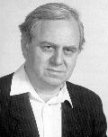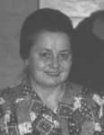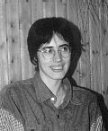| Our Staff (ordered by age) |
 | László Dobszay
[...] was born in Szeged in 1935. He studied history and literature at the Lóránd Eötvös University in Budapest and music at the Liszt Ferenc Academy of Music, with János Viski for composition, Iván Engel for piano, Zoltán Kodály for folk music and Bence Szabolcsi for music history. For a decade from 1956 he was principally occupied with pedagogical activities, writing papers, composing music and compiling materials as part of a wide-ranging reform of the Hungarian music teaching system.
In 1966 he was invited by Kodály and Benjamin Rajeczky to join the Folk Music Research Group of the Hungarian Academy of Sciences (which in 1974 was integrated into the newly formed Institute for Musicology). As well as undertaking field collections in North-East Hungary and Transylvania he worked on the classification of melody (from which was to emanate a new systematic catalogue of the entire corpus of Hungarian folksong, made in collaboration with Janka Szendrei) and comparative studies in the history of folksong on the one hand and that of written European melodic traditions on the other. At the same time László Dobszay was making equally fundamental contributions to liturgical chant studies, surveying sources and repertories and classifying their contents on a systematic melodic basis, with the result that when the call came to compile a new history of Hungarian music, the chapters on chant could be written with unique authority. Some of the research material compiled at this time as well as subsequently has been published in the series Corpus Antiphonalium Officii Ecclesiarum Centralis Europae (CAO-ECE). [...]
In 1970 László Dobszay was appointed teacher at the Liszt Ferenc Academy of Music, and in the same year he, Benjamin Rajeczky and Janka Szendrei founded the Schola Hungarica. He gained his doctorate in 1975 with a dissertation on melodies of the “lament style” in Hungarian music. In 1976 he was appointed head of the Early Music Department of the Institute for Musicology. He was a member of the Committee for the post-conciliar reform of Catholic church music in Hungary. In 1990 he became head of the Folk Music Department of the Institute, and in the same year head of the newly founded Church Music Department at the Liszt Ferenc Academy of Music.
[...] The [...] conferences on chant held in Hungary since 1984 [...] constitute meetings of the research group “Cantus Planus”, working under the aegis of the International Musicological Society. Their success, indeed the fact that they take place at all, is due almost entirely to László Dobszay and his Hungarian colleagues. For many of us, they have been the occasion for some of our finest experiences at scholarly conventions. [...] László Dobszay has made outstanding contributions not only to chant studies, and not only to musicology, but also to music teaching, to music in present-day Christian worship, and to the performance of music. [...] For example, as well as completing authoritative studies of the history and style of Latin chant, he has introduced chant into textbooks for school music right down to the primary level, he has adapted a very extensive corpus of chant for church worship in the vernacular, and with the Schola Hungarica has established new standards in the informed selection and performance of chant. [...] Another example of the mutually beneficial interaction of complementary branches of music in László Dobszay’s work is the way in which experience gained in folk music research has been utilized in his chant studies, most recently in the forthcoming systematic edition of the complete office antiphon repertory from Hungarian sources. His musicological studies also encompass the music of the sixteenth to eighteenth centuries, he is an authority on Bartók’s music, and he has had responsibility for the monumental series Musicalia Danubiana. Laudatio by David Hiley, from the book Laborare fratres in unum. Festschrift László Dobszay zum 60. Geburtstag. Hildesheim und Zürich: Weidmann, 1995. | |||
| His most important works | ||||
 | Janka Szendrei
She was born in Budapest in 1938, graduated as choir-master at the Liszt Academy of Music. During her studies she also took courses in musicology. She began her scholarly carreer as ethnomusicologist, her main fields of research being style analysis of the music of folk customs and the study of folk music in its historical context. She was member of the Historical and Systematic Study Group of the International Folkmusic Council and held lectures at its conferences. She was one of the founders of the Historical Song Collection of the Institute for Musicology and participated in the establishment and development of the catalogue of the Hungarian plainchant sources and melodies from the beginning (see: Collections).
In addition to the musical analysis of the plainchant repertory, she concentrated on research into codicology and paleography from 1970 on. She published two important works in these fields in 1981 and 1984: a general work on medieval Hungarian sources (A magyar középkor hangjegyes forrásai [Notated Sources in Medieval Hungary], Budapest, 1981) and a monograph about the Hungarian plainchant notation system (Középkori hangjegyírások Magyarországon [Medieval Notation Systems in Hungary], Budapest, 1984). She contributed to the large-scale volume of the Music History of Hungary (Middle Ages) with several important chapters (e.g. about the sources, notation, tropes and folk music in the Middle Ages).
She extended her paleographic research to other Central European and Western European notations as well, paying special attention to the period of the introduction of staff notation, the morphologic characteristics and cultural background of the different staff notations.
As a part of her research into the history of melody, she participated in the following activities:
- in writing a monograph about the melodies written down in the 16th-17th centuries and about their emergence in folk tradition;
From the 70s she has thought at the Liszt Academy of Music, first folk music, later paleography at the Department of Musicology, from 1991 gregorian chant at the Department of Church Music. Since 1997 she has been professor, from 2000 on head of the Church Music Department. She was one of the founders of the Schola Hungarica and fellow-conductor of its 45 records. She has been also one of the most important figures of the renewal of church music in Hungary, editor of the Catholic Hymnal and leader of a church choir for several decades. | |||
| Her most important works | ||||
 | Gábor Kiss was born in Budapest in 1960. After secondary school he studied the violoncello and became a teacher in 1983. He began his career as a music teacher and a performer. From 1987 onwards he also studied musicology at the Liszt Academy of Music in Budapest and graduated in 1992. One of the several fields that aroused his interest was ethnomusicology. In his diploma work he undertook the musical analysis of a definite melody layer of Hungarian folk music and he began dealing with musicology in the Folk Music Department of the Hungarian Institute for Musicology. Later he continued working in the Department of Early Music where he finished his dissertation in 1997 and took his PhD degree is 1998. In his dissertation he analyzed the medieval Hungarian ordinary repertory in the context of Central Europen traditions and also gave a complete catalogue of the Central Europen ordinary melodies. From 1998 on he began to develop a Digital Archive and Source Catalogue of medieval liturgical manuscripts with the aim to preserve and make accessible the medieval Hungarian manuscripts on CD. | |||
| His most important works | ||||
 | Ágnes Papp
was born in Budapest in 1967. After and partly simultaneously with secondary school she carried on studies in church music and playing the organ. She studied musicology between 1987--1992, church music between 1990--1995 at the Liszt Academy of Music in Budapest, where she graduated from musicology and church music in 1995, with the thesis Codex Kaioni (1634--1671). Since 1992 she has been assistant at the Department of Early Music at the Institute for Musicology of the Hungarian Academy of Sciences, first on a three-year scholarship from the Hungarian Academy of Sciences, since 1996 as a so-called ‘young researcher’. From 1996 to 1999 she was an individual postgraduate student at the Liszt Academy of Music. In 1997 she won the prize ‘Ciprian Porumbescu’ of the Romanian Academy for the publication of the Codex Kaioni (in co-operation with Romanian and Hungarian scholars), and in 2001 she was awarded the prize of the Hungarian Academy of Sciences for Young Scholars for the publication of a late medieval musical treatise from Transsylvania. Since 1991 she has participated in several meetings of the Cantus Planus Study Group of the IMS and read papers at conferences in Budapest, Cluj, Bratislava and München. In her dissertation in preparation she discusses the hypothetical medieval Hungarian tonary, reconstructed on the basis of the available manuscripts of the divine office. Her scope of research comprises the history of medieval music (first of all Gregorian chant); the history of Hungarian music in the 16th--17th centuries (mainly organ tabulatures and church music); organ music. | |||
| Her most important works | ||||
 | Zsuzsa Czagány was born in 1967 in Bratislava (Slovakia). She studied musicology and aesthetics at the Comenius University Bratislava. In 1989 she spent a month at the Musikhistorische Kommission der Bayerischen Akademie der Wissenschaften and the Bayerische Staatsbibliothek in Munich studying with Prof. Michael Bernhard, dealing with late medieval musical treatises from Central Europe. She graduated in musicology in 1990 with the thesis Anonymi Leutsoviensis Tractatus de musica. In 1990-91 she obtained a scholarship from the Bethlen Gábor Foundation for the study of medieval music at the Institute for Musicology in Budapest. In 1991-94 she won a three-year scholarship from the Sasakawa Young Leaders Fellowship Fund for the study and work at the same Institute, where she contributed to the series of CAO-ECE (Corpus Antiphonalium Officii Ecclesiarum Centralis Europae) with the volume II/A Bamberg, Temporale. For the latter she was awarded the prize of the Hungarian Academy of Sciences for Young Researcher in 1995. Since 1994 she has been assistant at the Institute for Musicology in Budapest. At present she carries on postgraduate studies at the Liszt Academy of Music in Budapest, her thesis in preparation deals with the Prague Office (her consultant is László Dobszay). Her other fields of research include the study of office-repertories in Central European dioceses, offices of regional saints, and late medieval music theory. | |||
| Her most important works | ||||
 | Orsolya Csomó was born in Budapest, 1970. She graduated from the Liszt Academy of Music first as a music teacher and choir conductor in 1993 then as church musician in 1996. She carried on postgraduate studies as church musician in 1996-1999, and got the certificate in 1999. At present she works on her DLA thesis dealing with the processional books of Zagreb Cathedral. Her main interest are medieval music and gregorian chant. Her other activities:
- secretary of the Hungarian Church Music society | |||
| Her most important works | ||||
 | Gergely Hajdú was born in Budapest, 1964, he studied history, literature and linguistics. Now he is responsible for editing the publications of the Department and some related organisational work. | |||
| The publications he designed | ||||